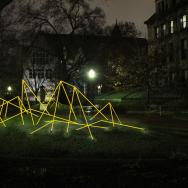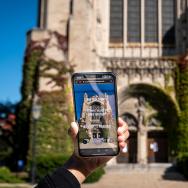An integral part of the University of Chicago undergraduate experience has always been the Humanities sequence in the Core curriculum. This year, a new component was added to the Humanities Core: first-year students within the same course section were primarily grouped in the same residential house. With this change, first-years have the opportunity to see their peers in both social and academic settings, living and learning together.
The Humanities (HUM) sequences are the only portion of the multidisciplinary Core curriculum that students must take as soon as they arrive on campus—creating a shared intellectual experience among students. This year, the HUM experience was updated to create more avenues for community-building during the COVID-19 pandemic.
As students embarked on their UChicago education during this unconventional year, the HUM living-learning communities allowed students to foster connections and continue learning beyond the walls of the classroom.
“As the only part of the College curriculum that all incoming students take in the first two quarters at UChicago, the HUM Core plays a pivotal role in initiating them into the College,” said Prof. Chris Wild, master of the Humanities Collegiate Division. “That includes not only our unique academic culture but also our intellectual and social community. By aligning housing with the HUM Core, we enable students to build on the bonds they form—both for their academic work as well their social life.
“Of course, COVID-19 does not allow us to harness the full potential of these newly formed learning-and-living communities. I hope we have the opportunity to try it again once the pandemic has abated. It can add significantly to the first-year experience.”
The living-learning communities also came with other new additions to the HUM Core this year designed to strengthen community. These included summer-reading suggestions for students within each sequence to give students a shared text leading up to their arrival on campus, as well as select outdoor, socially distanced seminars that took advantage of the fresh air on the UChicago Quad.
For first-year Vikram Mahendu, being in a house with his Reading Cultures class has positively affected his academic experience.
“After bumping into these people every day, it makes our classes feel like a discussion with friends—not with just peers and acquaintances,” Mahendu said. “Seeing those friendly faces around me gives me that extra little boost of confidence to raise my hand and stick my neck out in class.”
Valerie Levan, an assistant instructional professor in the Humanities Collegiate Division who teaches the Reading Cultures sequence of HUM, taught two HUM sections this quarter. In one of her sections, 13 of her 19 students all reside in Rogers House in Campus North Residential Commons. Levan has noticed that compared to previous years, her students are more comfortable and closer with one another.
“They all notice when someone is not there,” said Levan. “For them it changes the dynamic of the class when a person is missing and they know that person right away, which shows to me that it is a tighter-knit group.”
First-year Angie Zhu, one of Levan’s students, finds that her HUM class has a strong bond with one another.
“For me, I feel more connected to my classmates in my HUM class than any other class this year, and I’m sure that has a lot to do with the fact that we live together,” she said.
Mahendu believes that having his HUM class with housemates has created a positive experience that helped him feel connected in a time where community-building can be challenging:
“Personally, I really like being in the same HUM as the people in my house. I feel like it gives everyone something in common, which is great for making friends. especially in times of COVID,” he said. “Additionally, you see them every day in the hall as you go down to breakfast...and that makes their presence in the virtual classroom feel more personal.”
As students step into Winter Quarter and start to read Homer’s Odyssey, they too will face a journey ahead, but with the support of their HUM community, they’ll be ready to meet any obstacle together—even Scylla and Charybdis, or even a cyclops.
—This story was first published on the UChicago College website.

